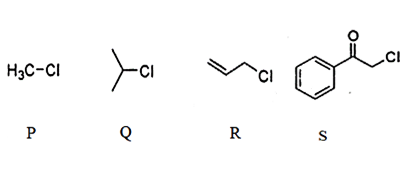When .17Cl35 undergoes (n,p) reaction, the radioisotope formed is a).15P32 b).16S35 c).16S34 d).15P34
15P32
16S35
16S34
15P34
The correct Answer is:B
17Cl35+0n1→16S35+1H1
Topper's Solved these Questions
- BOOK - DINESH PUBLICATIONCHAPTER - NUCLEAR AND RADIO CHEMISTRYEXERCISE - Revision Questions from Competitive Exams138videos
NUCLEAR AND RADIO CHEMISTRY
- BOOK - DINESH PUBLICATIONCHAPTER - NUCLEAR AND RADIO CHEMISTRYEXERCISE - Selected Straight Objected Type MCQs26videos
NUCLEAR AND RADIO CHEMISTRY
- BOOK - DINESH PUBLICATIONCHAPTER - NOMENCLATURE OF ORGANIC COMPOUNDSEXERCISE - MCQs13videos
NOMENCLATURE OF ORGANIC COMPOUNDS
- BOOK - DINESH PUBLICATIONCHAPTER - ORGANIC CHEMISTRY - SOME BASIC PRINCIPLES & TECHNIOUESEXERCISE - PURIFICATION & CHARACTERISATION OF ORGANIC COMPOUNDS38videos
ORGANIC CHEMISTRY - SOME BASIC PRINCIPLES & TECHNIOUES
Similar Questions
Knowledge Check
- Question 1 - Select One
A common example of β− decay is 15P32→16S32+x+y. Then, x and y stand for
Aelectron and neutrinoBpositron and neutrinoCelectron and anti-neutrinoDpositro and anti-neutrino - Question 2 - Select One
Nuclear reactions are given as
(i) □(n,p)15p32
(ii) □(p,α)8O16
(iii) .7□4(p).6C14
missing particle or nuclide (in box □ ) in these reactions are respectivelyAS32,F19,.0n1BF19,S32,.0n1CBe,F19,.0n1DNone of these
If ^18C15+218C16+17C16+1=nC3, then n=
View SolutionThe least among the following fractions is 1516 (b) 1920 (c) 2425 (d) 3435
View SolutionS={1,2,3,....20} if 3 numbers are chosen at random from S, the probability for they are in A.P. is (A) 338 (B) 3533 (C) 3335 (D)138
View SolutionComplete the equations for the following nuclear processes:
(a).3517Cl+.01n→...+.42He
(b) .23592U+.10n→...+.13754Xe+210n
(c) .2713Al+.42He→...+.10n
(d) ...(n,p).3516S
(e) .23994Pu(α,β−)...View Solution0.36 expressed in the form pq equals 411 (b) 413 (c) 3590 (d) 3599
View SolutionKl in acetone , undergoes SN2 reaction with each of P,Q,R,and S The rates of the reaction vary as
 View Solution
View Solution

